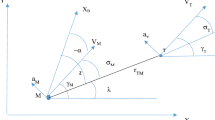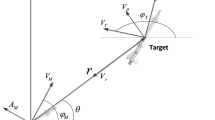Abstract
This paper presents a performance analysis of missile control systems considering nonlinear pursuit dynamics and proportional navigation guidance (PNG) laws. In order to analyze the system stability, missile dynamics are simplified as a linearized model which is often considered in missile autopilot design and the well-known \({{{H}}}_{\boldsymbol{\infty }}\) approach is employed. A sufficient condition guaranteeing miss distance and the closed loop stability is proposed. The provided condition of missile system stability can be numerically easily verified by a linear matrix inequality (LMI).







Similar content being viewed by others
References
Hong J-W, Song S-H, Ha I-J (2014) Singular perturbation like approach to compensation of actuator dynamics effect in missile control. IEEE Trans Aerosp Electron Syst 50(10):238–248
Song S-H, Ha I-JA (1994) Lyapunov-like approach to performance analysis of 3-dimensional pure PNG laws. IEEE Trans Aerosp Electron Syst 30(1):238–248
Balakrishnan SN, Tsourdos A, White BA (2013) Advances in missile guidance, control, and estimation. CRC Press, New York
Blakelock JH (1991) Automatic control of aircraft and missile. Wiley, New York
M. Guelman (1990) The stability of proportional navigation systems. In: AIAA conference, pp 586–590
Doyle JC, Glover K, Khargonekar PP, Francis BA (1989) State-space solutions to standard H2 and H∞ control problems. IEEE Trans Autom Control 38(8):831–847
Zhou K, Khargonekar PP (1988) An algebraic riccati equation approach to H1 optimization. Syst Control Lett 11:85–91
Gahinet P, Apkarian P (1994) A linear matrix inequality approach to H∞ control. Int J Robust Nonlinear Control 4:421–448
Horn RA, Johnson CR (1990) Matrix analysis. Cambridge University Press, Cambridge
Shamma JS, Cloutier JR (1993) Gain-scheduled missile autopilot design using linear parameter varying transformation. J Guidance Control Dyn 16(2):257–263
Kim J, Lyou J (2008) Absolute stability margins in missile guidance loop. Int J Control Autom Syst 6(3):460–466
Fu Z, Dai Y, Zhang K (2017) Research progress on design methods for missile integrated guidance and control. In: International conference on automation, control and robotics, pp 15–19
Acknowledgements
This work was supported by Hallym University Research Fund HRF-202005-020.
Author information
Authors and Affiliations
Corresponding author
Additional information
Publisher's Note
Springer Nature remains neutral with regard to jurisdictional claims in published maps and institutional affiliations.
Rights and permissions
About this article
Cite this article
Song, SH. \({H}_{\infty }\) Approach to Performance Analysis of Missile Control Systems with Proportional Navigation Guidance Laws. J. Electr. Eng. Technol. 16, 1083–1088 (2021). https://doi.org/10.1007/s42835-020-00617-0
Received:
Revised:
Accepted:
Published:
Issue Date:
DOI: https://doi.org/10.1007/s42835-020-00617-0




